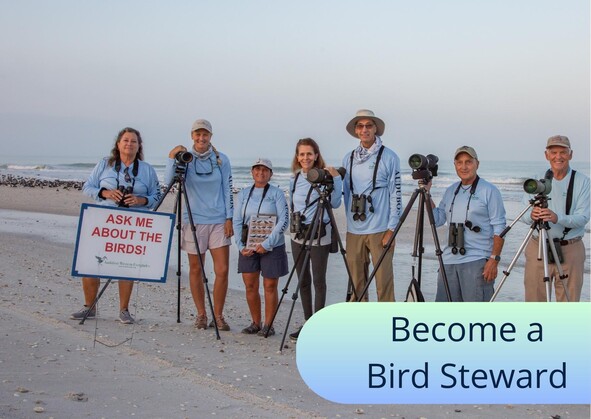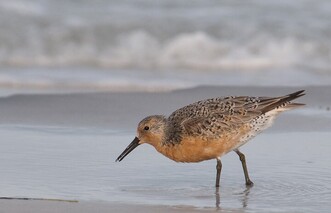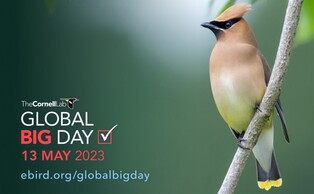Events:
May 13: Global Big Day and World Migratory Bird Day
Bird Stewardship Training:
May 9, 10:30am CST: St. Joseph Peninsula State Park. Email Brian Cammarano.
May 17, 7pm EST: Sarasota County. Register online.
May 23, 7pm EST: 3 Rooker Island. Register online.
May 24, 7pm EST: Pinellas County. Register online.
Reminders:
May 13 - 19: the May count window for the Breeding Bird Protocol. Whenever possible, weekly surveys are preferred for routes with active nesting; it helps capture information about peak counts.
May 26 - 29: Memorial Day Holiday! Shorebirds and seabirds nesting along the coast need more support during busy holiday weekends. Can you help? If so, contact a local Stewardship Coordinator.

Audubon bird stewards photo by Jean Hall
If you like talking about birds, and want to be a part of essential shorebird and seabird conservation work in Florida, consider becoming a Bird Steward!
Bird stewards play an important role in shorebird conservation by chaperoning nesting sites and chicks on busy beaches. While chaperoning sites, stewards also educate beachgoers about the incredible birds that rely on Florida's coasts to breed, feed, and rest. Bird Stewards are needed at shorebird nesting areas during the breeding season, especially during high beach traffic weekends and holidays. Learn more about becoming a Bird Steward.
To sign up, contact your local Audubon Stewardship Coordinator below and they will get you trained to be a Bird Steward. Training includes information about the specifics of the nesting site, how to identify imperiled shorebird species of Florida and how to effectively educate the public. Your stewardship is greatly needed and appreciated!
Northeast:
Chris Farrell - All locations in Nassau, Duval, and St. Johns counties. Chris.Farrell@audubon.org
Florida Panhandle:
Caroline Stahala - Pensacola Beach, Navarre Beach & Causeway in Santa Rosa County. Beaches in Walton, Bay, Gulf, and Franklin counties. Rooftop monitoring and chick-checking at various sites from Pensacola to Panama City area: Caroline.Stahala@audubon.org
Southwest Florida:
Mark Rachal - Wading bird nesting colonies in Hillsborough, Pasco, Pinellas, Manatee, and Sarasota counties: Mark.Rachal@audubon.org
Abby McKay - Ft. De Soto Park, St. Pete Beach in South Pinellas County: Abby.Mckay@audubon.org
Kim Scottaline - Redington Shores, Sand Key Park in mid-Pinellas County: Kim.Scottaline@audubon.org
Emalee Herrera - Three Rooker Island, located north of Honeymoon Island with boat transportation provided for volunteers: Emalee.Herrera@audubon.org
Kara Cook - Rooftop monitoring and chick-checking at various sites in Pinellas, Hillsborough, Manatee, and Sarasota counties: Kara.Cook@audubon.org
Kylie Wilson - Siesta Key, Lido Key, Longboat Key in Sarasota County: Kylie.Wilson@audubon.org
Stephanie Wagley - Carlos Pointe Beach in Lee County: leeshorebirdstewards@gmail.com
Robin Serne - Marco Island/Sand Dollar Beach in Collier County: colliershorebirdstewards@gmail.com

Waterbird Society Annual Meeting
The Waterbird Society will hold its 47th Annual Conference in Fort Lauderdale, Florida, USA. The conference will be a joint meeting with the Atlantic Marine Bird Cooperative (AMBC) and hosted by the Florida Fish and Wildlife Conservation Commission.
The conference will be held at Gallery One-a Double Tree Suites by Hilton Hotel in Fort Lauderdale. The conference will include a diverse selection of symposia on the research and management of waterbirds as well as general presentations and a poster session. The conference team is also planning to offer workshops or training seminars. Potential workshops/training may include the use of unmanned aerial vehicles, autonomous recording units, R packages for statistical programming, necropsy, and grant writing. Information on the available workshops/training will continue to be updated. If you have expertise on any of these topics or have an idea for another workshop and/or would be willing to help lead a workshop, please contact ricardo.zambrano@waterbirds.org
To register and submit abstracts please click HERE. Before registering, first create an account.
Important deadlines:
July 1: Deadline for early bird registration
August 10: Deadline for abstract submittal
September 8: Deadline for hotel reservations at conference rates
Three ways to book your hotel reservation:
- Follow link below, click on the "Book A Room" button, then "EDIT STAY" link on right side to request the specific dates you are travelling to make a reservation on our personalized group web page: Private Booking Page WBS 2023
- Go onto galleryone.doubletree.com and make a reservation through the main page. Once you have entered in the dates, you have an option to put in a Reservation Group Code which is: WSA
- Call the Reservations Hotline at 800-222-TREE (8733)and ask for the group rate under the Waterbird Society Annual Meeting.
City View Rate: $145 per night plus taxes
Intracoastal View rate: $155 per night plus taxes
|

U.S. Fish and Wildlife Service Finalizes Recovery Plan for Rufa Red Knot
The U.S. Fish and Wildlife Service has finalized the recovery plan for the rufa red knot, a subspecies that was listed as threatened under the federal Endangered Species Act in 2015. The plan is available here.
The recovery plan reflects input from natural resource agencies and conservation organizations across the species’ range. The plan outlines objectives, and measurable criteria for removing the rufa red knot from the endangered and threatened species list, and actions managers can take to advance recovery.
The Service is also finishing an accompanying Recovery Implementation Strategy that will step down the actions from the recovery plan into detailed activities.
Additional information about the knot can be found at the Service’s rufa red knot species profile page.
Red knot photo by Mia McPherson
|

All About Rooftops
The 2023 breeding season is here, and rooftop-nesting birds are starting to nest! Here are a few tips on entering rooftop data, updating rooftop details, and how to retire rooftops.
Thank you to all FSA partners who have been busy collecting and entering data so far! If you have questions or need assistance with data entry or collection, email us at FLShorebirdDatabase@MyFWC.com. We are happy to help!
Rooftop Data Entry Tips
When entering rooftop surveys into the FSD, there are three options to report rooftop nesting status:
-
No nesting yet this year: If no shorebirds or seabirds have been seen at the rooftop yet this breeding season, then the nest status should be reported as No Nesting Yet This Year.
-
Active: As soon as a rooftop nesting shorebird or seabird is seen using the roof, then the nest status should be reported as Active. The rooftop will be considered Active for as long as birds are seen or heard on roof, hovering over the roof, or flying to and from the roof.
-
No longer active: Rooftops are considered No Longer Active when the birds that were nesting on the rooftop are not currently present at the rooftop.
Remember that a rooftop can only be reported as No Longer Active if the rooftop has been Active at least once during the current breeding season. Likewise, once a rooftop has been reported as Active, it cannot later be reported as No Nesting Yet This Year. Instead, it should be reported as No Longer Active. If birds return to the rooftop, then the rooftop can be reported as Active again.

Updating Rooftop Details
As rooftops begin to become busy with nesting shorebirds and seabirds, you may find that the rooftop you survey has changed ownership or has a new management. Or perhaps a new chick checking program was established or protective measures like drain covers were installed. You can update this rooftop information in the FSD by following the steps below:
- Log into your FSD account and click on the View/Edit button beside the rooftop in your My Rooftops box.
- Click on the View/Edit Rooftop Management Details button in the Site Summary box.
- Update the desired fields (e.g., the building or business name, contact information, chick checking program, etc.).
- Click on the Submit button at the bottom of the popup to save changes.
Retiring Rooftops
We retire a rooftop from the FSD when a rooftop is no longer suitable for nesting, such as when a rooftop is reroofed with non-gravel material or the building is torn down. A rooftop that has been deemed no longer suitable for nesting does not need to be monitored. The FSD data team will retire the rooftop from the database, and you can focus your monitoring efforts elsewhere.
Do you know of a rooftop that needs to be retired? Let the FSD data team know by following these steps below:
- Confirm when and why the rooftop is no longer suitable (e.g., the rooftop substrate is no longer gravel because it was re-roofed in January 2023).
- Log into your FSD account and click the View/Edit button beside the rooftop in your My Rooftops box.
- Click on the Remove from My Data button in the Site Summary box.
- Select Rooftop Unsuitable from the Removal Reason dropdown menu.
- Use the Additional Information box to report approximately when and why the rooftop is no longer suitable for nesting.
- Click the Yes, Remove from My Data This will alert the FSD data team that the rooftop needs to be retired and will also remove the rooftop from your FSD profile.
The FSD data team retires rooftops in batches several times a year. There may be a delay between when you report a rooftop for retirement and when the rooftop is retired from the database. Your participation in this process helps us keep the list of suitable rooftops as accurate as possible!

2023 Global Big Day
Be a part of birding’s biggest team! Global Big Day is an annual celebration of the birds around you. Join on May 13, help celebrate World Migratory Bird Day, and share the birds you find with eBird.
Participating is easy — if you have 5 or 10 minutes, report your bird observations to eBird online or with the free eBird Mobile app. If you have more time, submit several checklists of birds throughout the day. Your observations help to better understand global bird populations through products like these animated abundance maps brought to you by eBird Science.
Last year, Global Big Day brought birders together virtually from more countries than ever before. More than 51,000 people from 201 countries submitted a total of 132,000 checklists with eBird, setting new world records for a single day of birding.
Learn more and participate at Global Big Day 2023.
|
|